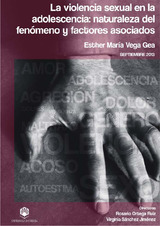Mostrar el registro sencillo del ítem
La violencia sexual en la adolescencia: naturaleza del fenómeno y factores asociados
| dc.contributor.advisor | Ortega Ruiz, Rosario | |
| dc.contributor.advisor | Sánchez Jiménez, Virginia | |
| dc.contributor.author | Vega Gea, Esther María | |
| dc.date.accessioned | 2014-03-07T13:17:40Z | |
| dc.date.available | 2014-03-07T13:17:40Z | |
| dc.date.issued | 2014 | |
| dc.identifier.uri | http://hdl.handle.net/10396/11954 | |
| dc.description.abstract | La adolescencia se caracteriza por ser un periodo evolutivo en el que se producen cambios fisiológicos, psicológicos y sociales importantes (Albert y Steinberg, 2011; Belsky, 2007). En este sentido, la maduración biológica de chicos y chicas, tendrá grandes repercusiones en la calidad de las relaciones interpersonales de los mismos (Coleman y Hendry, 1999; Dahl y Gunner, 2009; Steinberg, 2005), puesto que muchas de las interacciones que iniciarán estarán teñidas de atracción sexual (Belsky, 2012; Oliva, 2003; Ortega-Rivera, Ortega y Sánchez, 2010). Así, en las relaciones que hasta el momento eran únicamente de amistad puede aparecer un componente sexual. En este contexto, los grupos de amigos, hasta ahora unisexuales, comienzan a transformarse progresivamente en grupos mixtos, lo cual hace necesario el reajuste de las formas de interrelación dentro del grupo (Dunphy, 1963). Por lo tanto, sería imprescindible un aprendizaje que les permita modular y expresar de forma correcta estos nuevos sentimientos de carácter sexual, según las normas socialmente aceptadas. Sin embargo, las dificultades en este proceso de aprendizaje pueden dar lugar a comportamientos sexuales violentos entre iguales (Lacasse et al. 2003; Maccoby, 1998; McMaster, Conolly, Pepler y Craig, 2002; Ortega, Sánchez, Ortega-Rivera, Menesini y Nocentini, 2010). Este fenómeno de la violencia sexual entre adolescentes es un tópico que está tomando especial relevancia en las últimas décadas, si bien, no existe aún un consenso general sobre su naturaleza, prevalencia y dimensiones (AAUW, 1993, 2001; McMaster et al., 2002; Ortega et al., 2010; Witkowska y Kjellberg, 2005). Además, la escasez o falta de estudios en Andalucía sobre la violencia sexual entre iguales adolescentes manifiesta la necesidad de estudiar y abordar esta problemática adolescente en la actualidad. El presente trabajo se marcó principalmente dos grandes objetivos. En primer lugar, se propuso testar la estructura factorial del modelo de acoso sexual en chicas y chicos (AAUW,... | es_ES |
| dc.description.abstract | 1. Introduction or incentive of the thesis Adolescence is an evolutive period in which very important physiological, psychological and social changes take place (Albert y Steinberg, 2011; Belsky, 2007). In this way, boys and girls’ biological maduration will have major implications in the quality of their inter-personal relationships (Coleman y Hendry, 1999; Dahl y Gunner, 2009; Steinberg, 2005), because much of these interactions will include some sexual attraction (Belsky, 2012; Oliva, 2003; Ortega- Rivera, Ortega y Sánchez, 2010). So, in those relationships, that until now were based on friendship, a sexual component could appear. In this context, unisexual peer groups begin their progressive transformation into mixed-gender groups, and this causes the need for readjustment of interaction forms within the group (Dunphy, 1963). Therefore, a learning process that enable them to modulate and state these new sexual feelings in an appropriate way would be essential. However, difficulties can be found in this learning process and it may cause violent sexual behaviors between peers (Lacasse et al. 2003; Maccoby, 1998; McMaster, Conolly, Pepler y Craig, 2002; Ortega, Sánchez, Ortega-Rivera, Menesini y Nocentini, 2010). The phenomenon of peer sexual violence between adolescents has been becoming a specially relevant topic during last decades, even though there is no general consensus about its nature, prevalence and dimensions (AAUW, 1993, 2001; McMaster et al., 2002; Ortega et al., 2010; Witkowska y Kjellberg, 2005). Also, scarce investigations focused on adolescent peer sexual harassment were carried out in Andalusia, so approaching this important adolescent problem becomes necessary nowadays. The present study set two main aims. Firstly, test the sexual harassment model factorial structure on boys and girls (AAUW, 1993, 2001; McMaster et al., 2002; Ortega et al., 2010) on a sample of Andalusian adolescents. Next, analize the prevalence of the phenomenom using different indicators: involvement, chronicity, variety, severity and roles, in function of gender and age of adolescents... | es_ES |
| dc.format.mimetype | application/pdf | es_ES |
| dc.language.iso | spa | es_ES |
| dc.publisher | Universidad de Córdoba, Servicio de Publicaciones | es_ES |
| dc.rights | https://creativecommons.org/licenses/by-nc-nd/4.0/ | es_ES |
| dc.subject | Violencia sexual | es_ES |
| dc.subject | Adolescencia | es_ES |
| dc.subject | Afectividad | es_ES |
| dc.subject | Acoso sexual | es_ES |
| dc.subject | Relaciones sociales | es_ES |
| dc.subject | Actitud sexista | es_ES |
| dc.subject | Personalidad | es_ES |
| dc.subject | Comportamiento | es_ES |
| dc.subject | Comportamiento sexual violento | es_ES |
| dc.title | La violencia sexual en la adolescencia: naturaleza del fenómeno y factores asociados | es_ES |
| dc.type | info:eu-repo/semantics/doctoralThesis | es_ES |
| dc.rights.accessRights | info:eu-repo/semantics/openAccess | es_ES |

